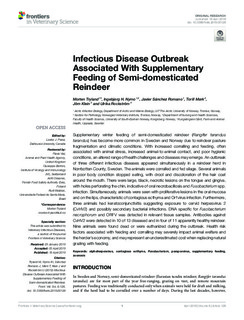| dc.contributor.author | Tryland, Morten | |
| dc.contributor.author | Nymo, Ingebjørg Helena | |
| dc.contributor.author | Sanchez Romano, Javier | |
| dc.contributor.author | Mørk, Torill | |
| dc.contributor.author | Klein, Jörn | |
| dc.contributor.author | Rockström, Ulrika | |
| dc.date.accessioned | 2019-08-07T09:29:25Z | |
| dc.date.available | 2019-08-07T09:29:25Z | |
| dc.date.created | 2019-06-05T11:17:20Z | |
| dc.date.issued | 2019 | |
| dc.identifier.citation | Frontiers in Veterinary Science. 2019, 6, 1-8. | nb_NO |
| dc.identifier.issn | 2297-1769 | |
| dc.identifier.uri | http://hdl.handle.net/11250/2607414 | |
| dc.description | This is an open-access article distributed under the terms of the Creative Commons Attribution License (CC BY). The use, distribution or reproduction in other forums is permitted, provided the original author(s) and the copyright owner(s) are credited and that the original publication in this journal is cited, in accordance with accepted academic practice. No use, distribution or reproduction is permitted which does not comply with these terms. | nb_NO |
| dc.description.abstract | Supplementary winter feeding of semi-domesticated reindeer (Rangifer tarandus tarandus) has become more common in Sweden and Norway due to reindeer pasture fragmentation and climatic conditions. With increased corralling and feeding, often associated with animal stress, increased animal-to-animal contact, and poor hygienic conditions, an altered range of health challenges and diseases may emerge. An outbreak of three different infectious diseases appeared simultaneously in a reindeer herd in Norrbotten County, Sweden. The animals were corralled and fed silage. Several animals in poor body condition stopped eating, with drool and discoloration of the hair coat around the mouth. There were large, black, necrotic lesions on the tongue and gingiva, with holes perforating the chin, indicative of oral necrobacillosis and Fusobacterium spp. infection. Simultaneously, animals were seen with proliferative lesions in the oral mucosa and on the lips, characteristic of contagious ecthyma and Orf virus infection. Furthermore, three animals had keratoconjunctivitis suggesting exposure to cervid herpesvirus 2 (CvHV2) and possibly secondary bacterial infections. DNA specific for Fusobacterium necrophorum and ORFV was detected in relevant tissue samples. Antibodies against CvHV2 were detected in 10 of 13 diseased and in four of 11 apparently healthy reindeer. Nine animals were found dead or were euthanized during the outbreak. Health risk factors associated with feeding and corralling may severely impact animal welfare and the herder's economy, and may represent an underestimated cost when replacing natural grazing with feeding. | nb_NO |
| dc.language.iso | eng | nb_NO |
| dc.rights | Navngivelse 4.0 Internasjonal | * |
| dc.rights.uri | http://creativecommons.org/licenses/by/4.0/deed.no | * |
| dc.title | Infectious Disease Outbreak Associated with Supplementary Feeding of Semi-Domesticated Reindeer | nb_NO |
| dc.type | Journal article | nb_NO |
| dc.type | Peer reviewed | nb_NO |
| dc.description.version | publishedVersion | nb_NO |
| dc.rights.holder | © 2019 Tryland, Nymo, Sánchez Romano, Mørk, Klein and Rockström | nb_NO |
| dc.source.pagenumber | 1-8 | nb_NO |
| dc.source.volume | 6 | nb_NO |
| dc.source.journal | Frontiers in Veterinary Science | nb_NO |
| dc.identifier.doi | 10.3389/fvets.2019.00126 | |
| dc.identifier.cristin | 1702892 | |
| cristin.unitcode | 222,56,1,0 | |
| cristin.unitname | Institutt for sykepleie- og helsevitenskap | |
| cristin.ispublished | true | |
| cristin.fulltext | original | |
| cristin.qualitycode | 1 | |

